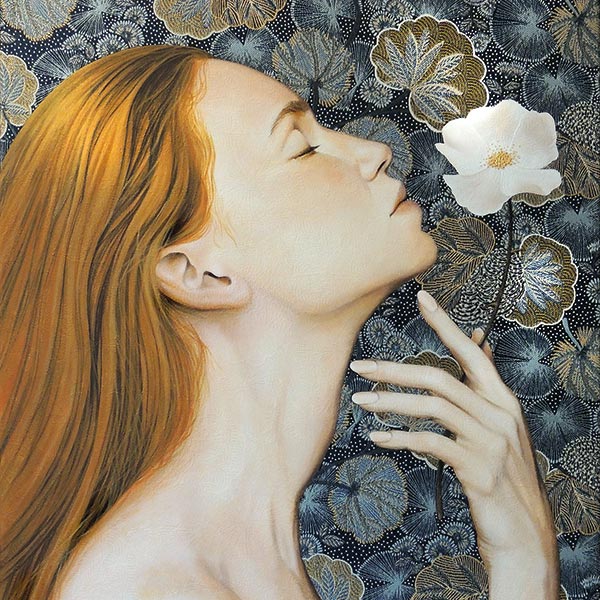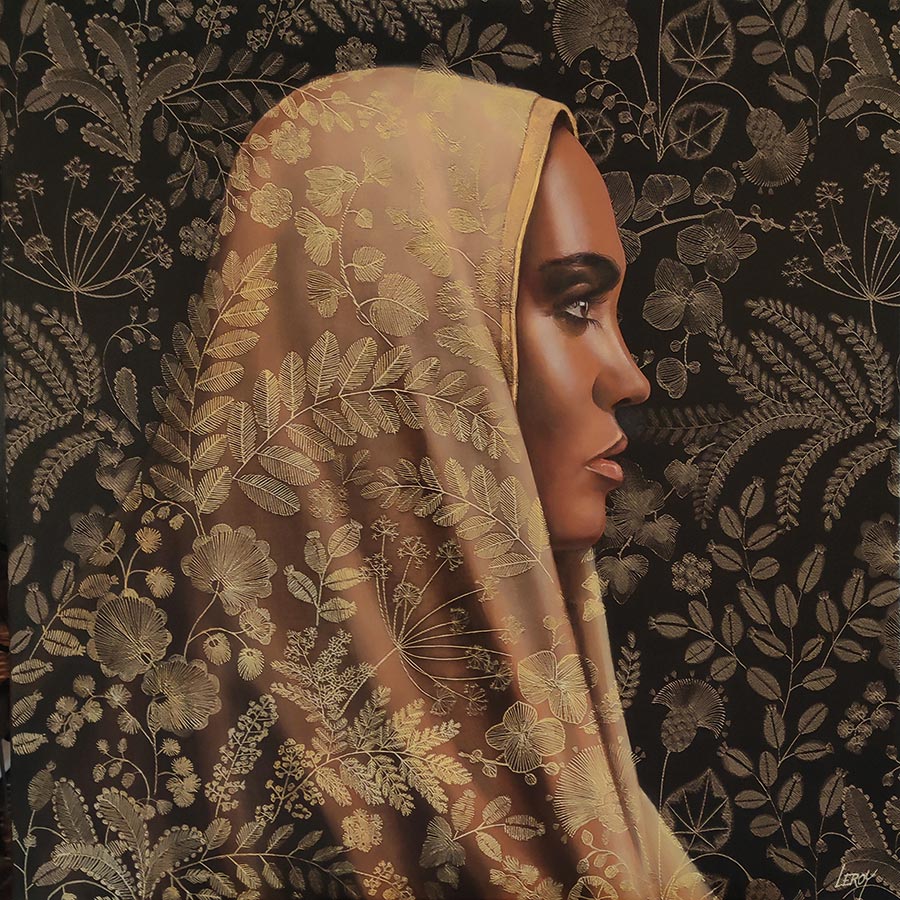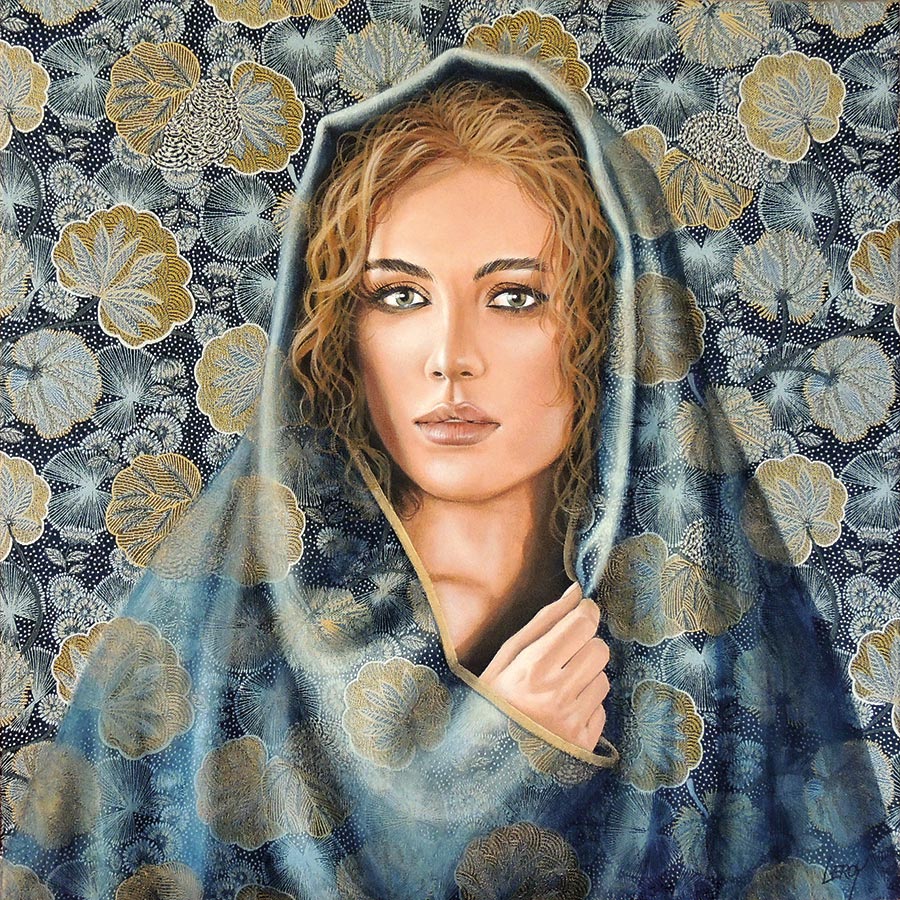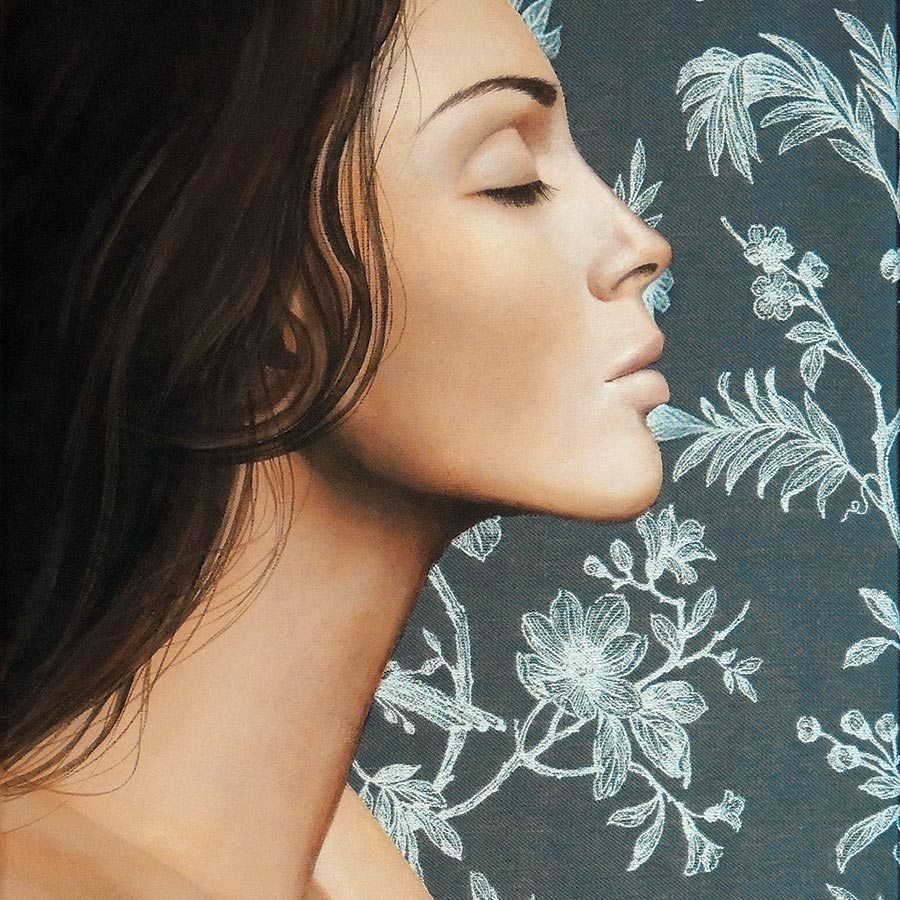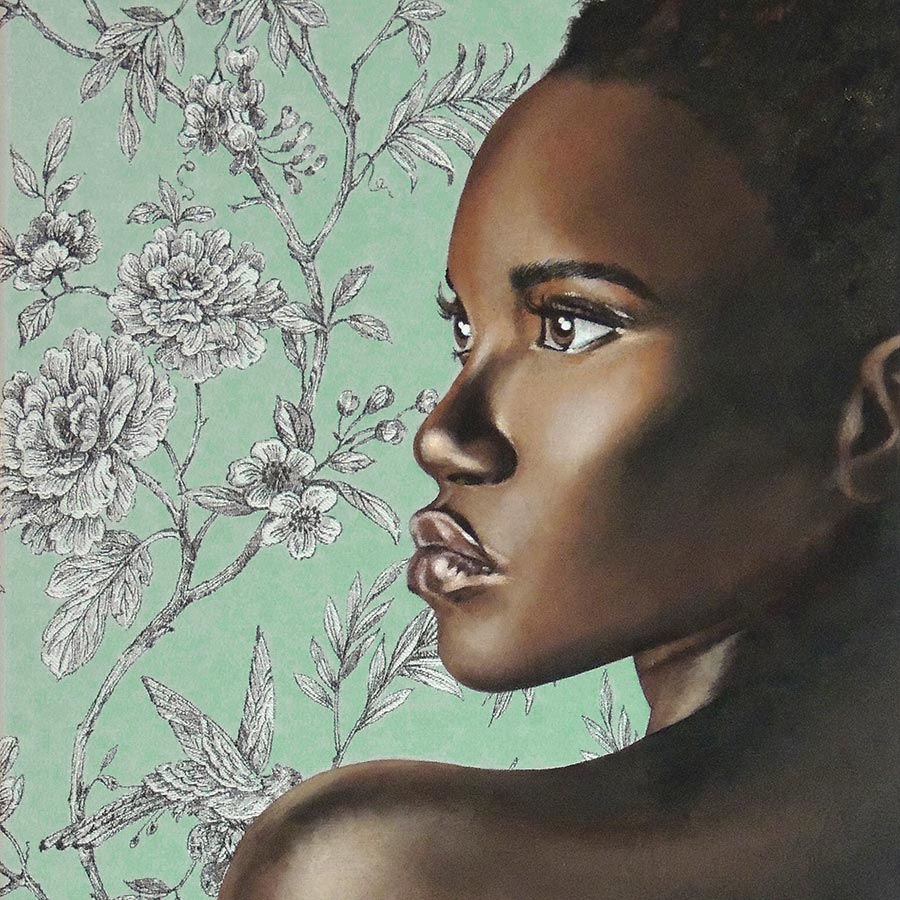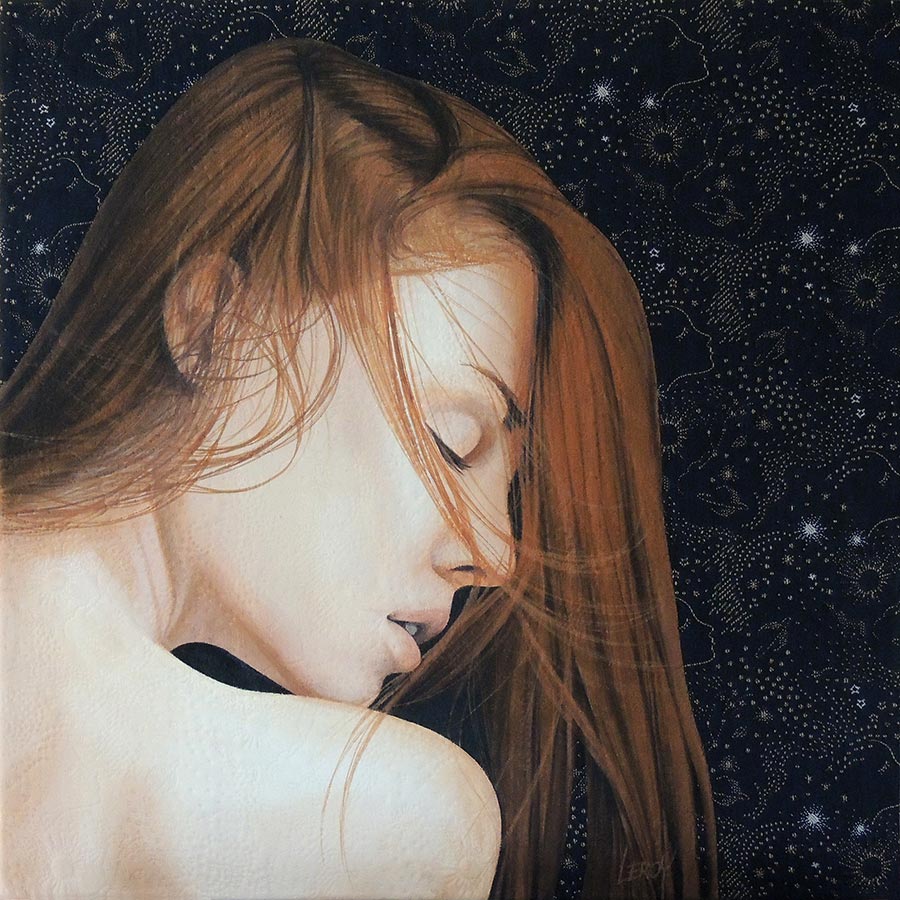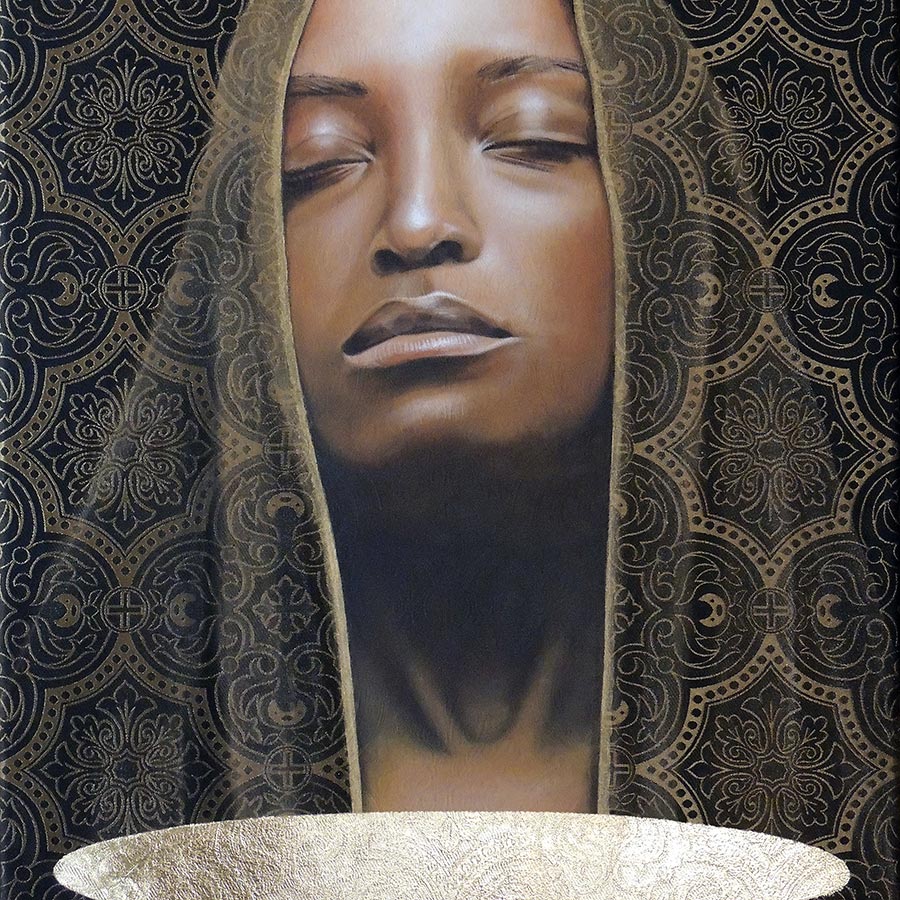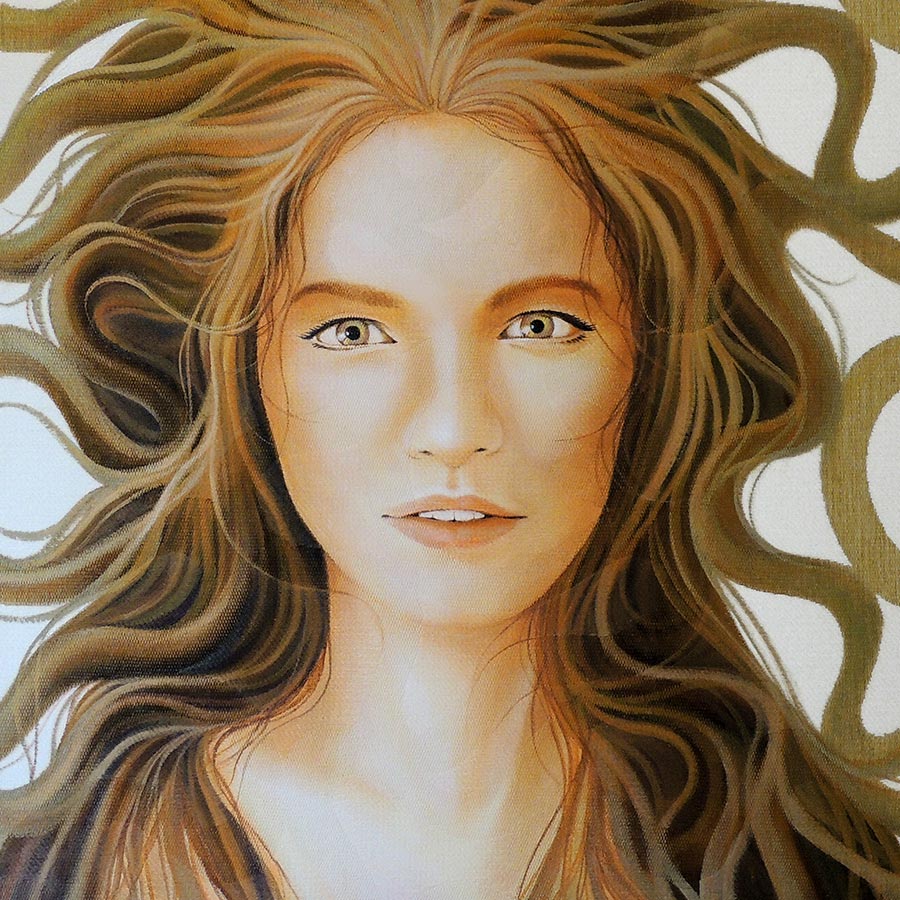Dans cette nouvelle série, le sujet est peint directement sur un support inédit, un tissu épais : jacquard ou brocart. La peinture joue avec les fibres et la lumière, et laisse percevoir les reliefs du tissu comme autant d’ornements, tatouages ou scarifications. L’histoire se révéle alors, entrecroisée de fils d’Ariane et enluminée d’or ou d’argent. Sur le fil, chaque portrait est une prise de risque à la fois tactile et indicible. Il faut accepter la contrainte du support et sa propre sensibilité sans jamais les opposer. Ainsi naît la sincérité d’un seul message, celui de la dignité. Cette série est composée de trois thèmes intitulés : Florebo Quocumque Ferar, Texere Texte Textile et Divine Comédie.
In this new ‘Mix weave’ series, the subject is painted directly on an original support: a thick fabric: jacquard or brocade. The paint plays with the fibers and the light, and reveals the reliefs of the fabric like so many ornaments, tattoos or scarifications. The story is revealed, crisscrossed with Ariadne’s threads and illuminated with gold or silver. On the wire, each portrait is a risk-taking that is both tactile and inexpressible. You have to accept the constraint of the support and your own sensitivity without ever opposing them. Thus is born the sincerity of a single message, that of dignity. This series is made up of three themes entitled: Florebo Quocumque Ferar, Texere Texte Textile and Divine Comédie.
I
Florebo Quocumque Ferar
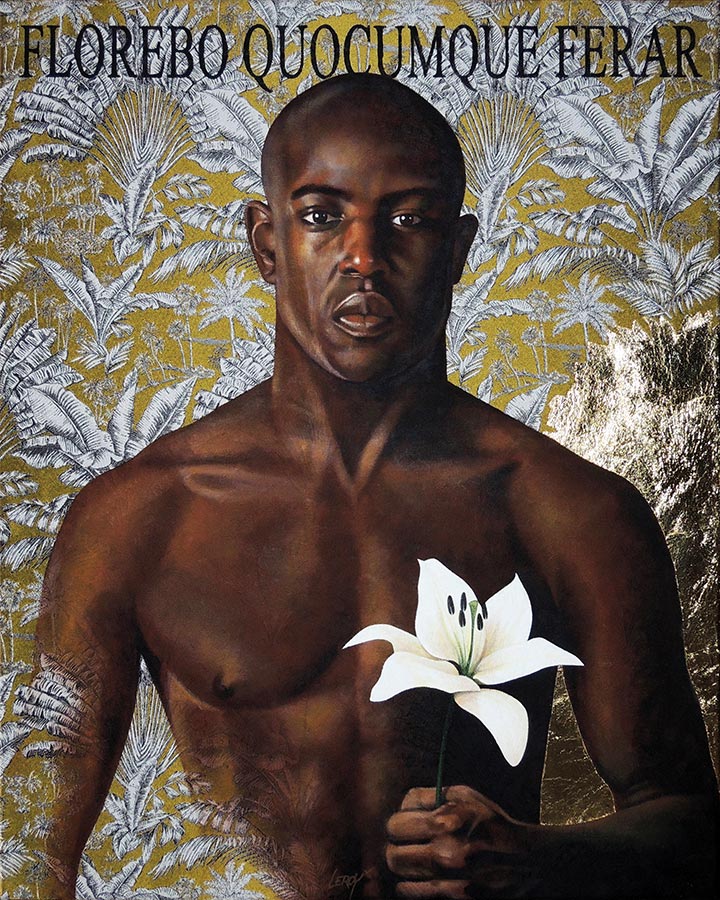
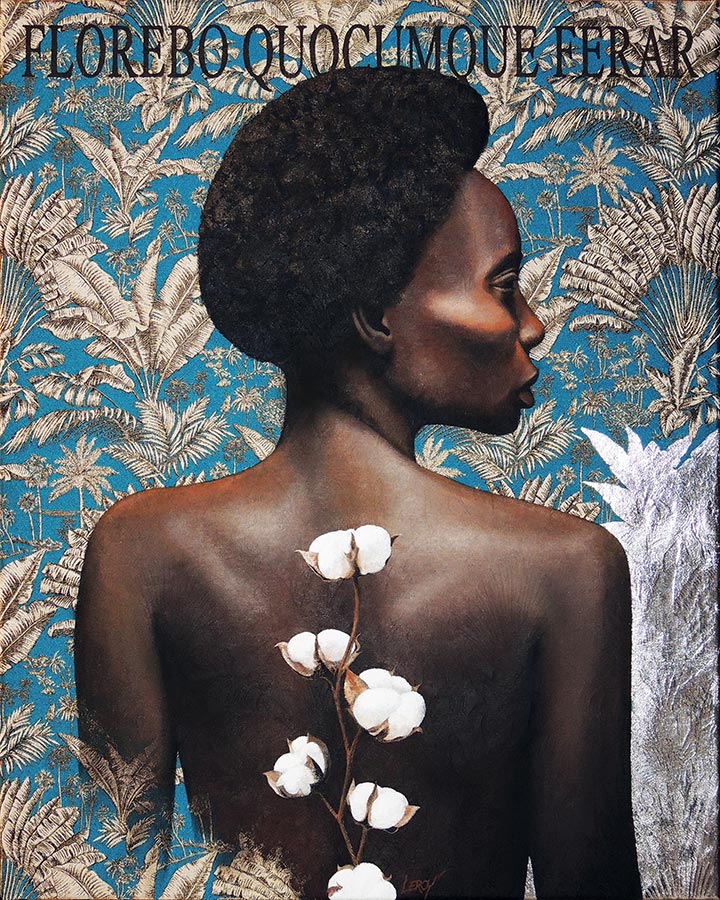
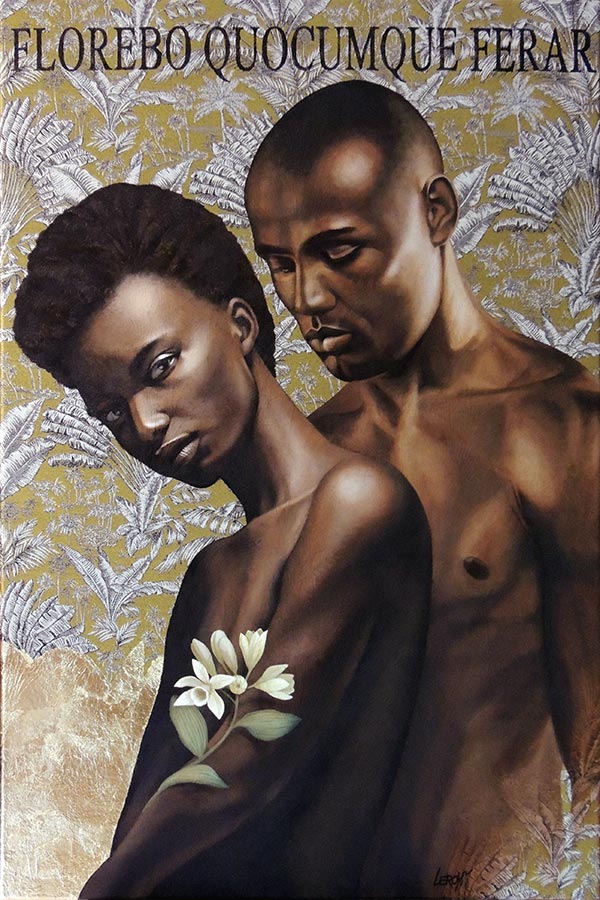
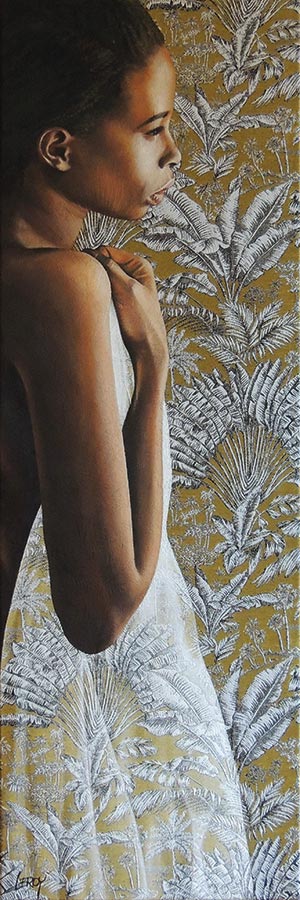
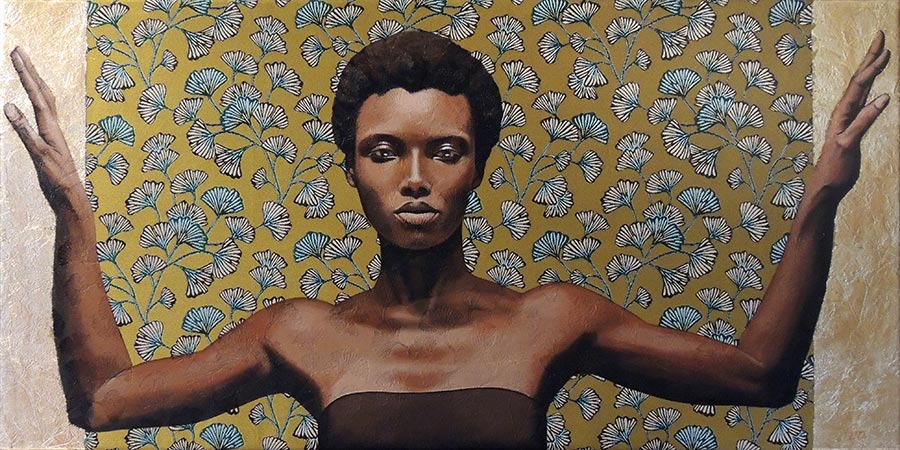
Ces tableaux sont un travail de mémoire sur la traite négrière et l’esclavage en prenant comme base la devise de la Compagnie des Indes Orientales au XVIIIe siècle ‘Florebo quocumque ferar’ (Je fleurirai partout où je serai portée). Ces portraits sont narratifs avec une représentation puissante et respectueuse des caractères humains accompagnée de symboles comme le lys, le coton, l’or ou l’argent qui soulignent le côté abjecte de ce commerce triangulaire. Esclaves d’hier ou migrants d’aujourd’hui, ils nous invitent à réfléchir sur notre capacité à être tolérants et sincères dans notre repentir. Au-delà de l’aspect figuratif, mon travail se veut la transposition picturale d’une dialectique humaniste entre époques, cultures et personnalités.
These paintings are a work of memory on the slave trade and slavery, taking as a basis the motto of the East India Company in the 18th century ‘Florebo quocumque ferar’ (I will bloom wherever I am carried). These portraits are narrative with a powerful and respectful representation of human characters accompanied by symbols such as lily, cotton, gold or silver which underline the abject side of this triangular trade. Yesterday’s slaves or today’s migrants, they invite us to reflect on our capacity to be tolerant and sincere in our repentance. Beyond the figurative aspect, my work is the pictorial transposition of a humanist dialectic between times, cultures and personalities.
II
Texere Texte Textile
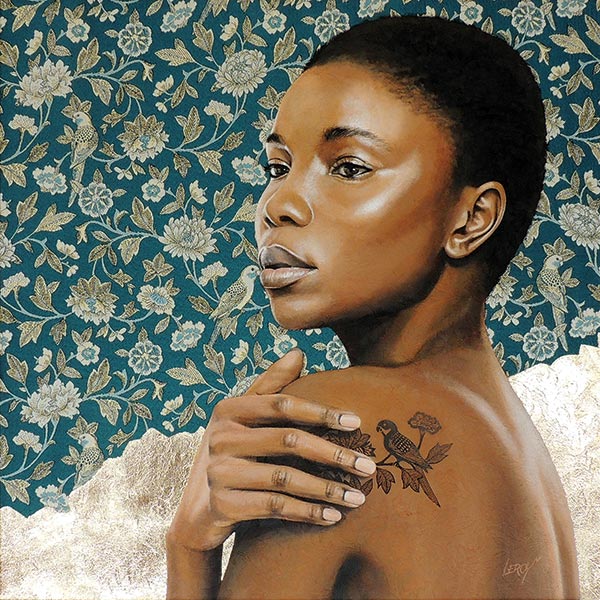
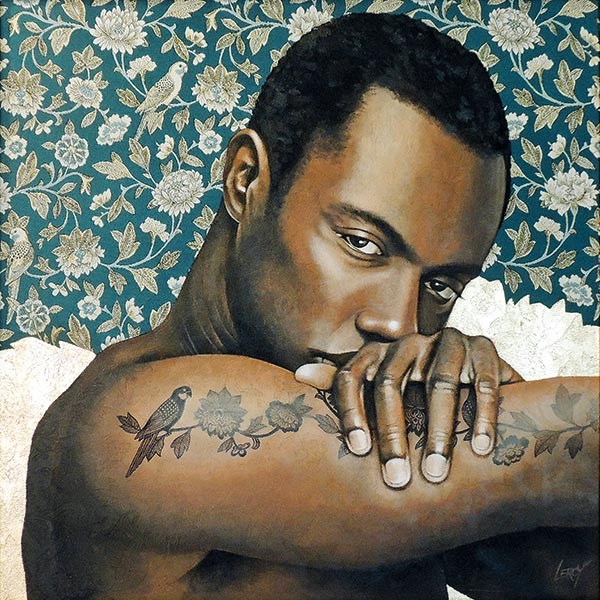
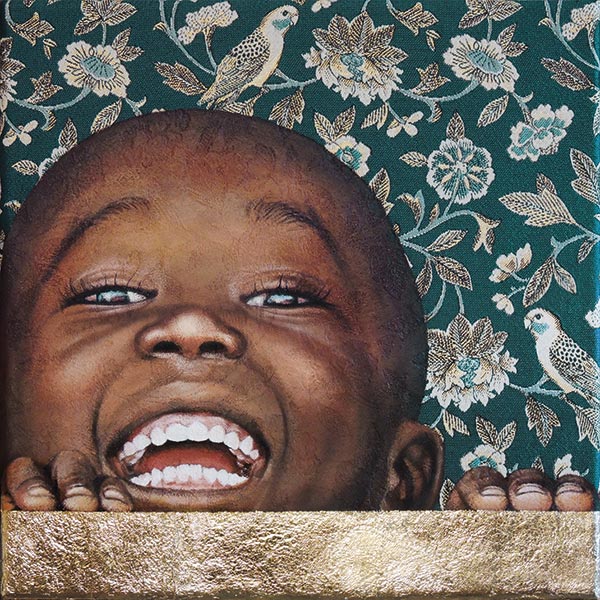
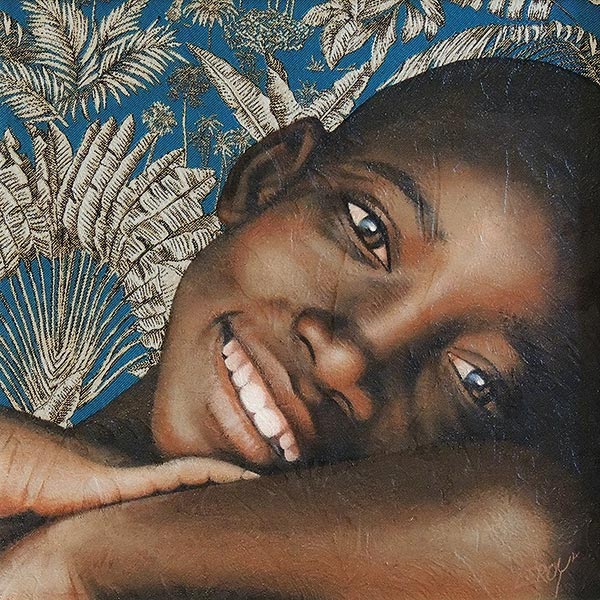
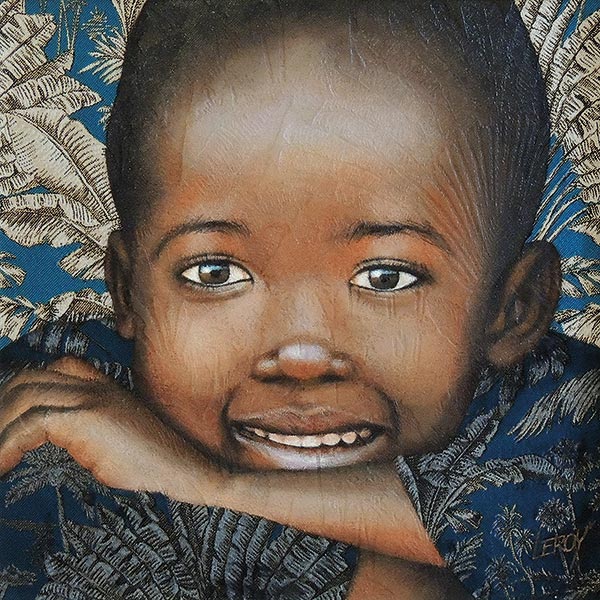
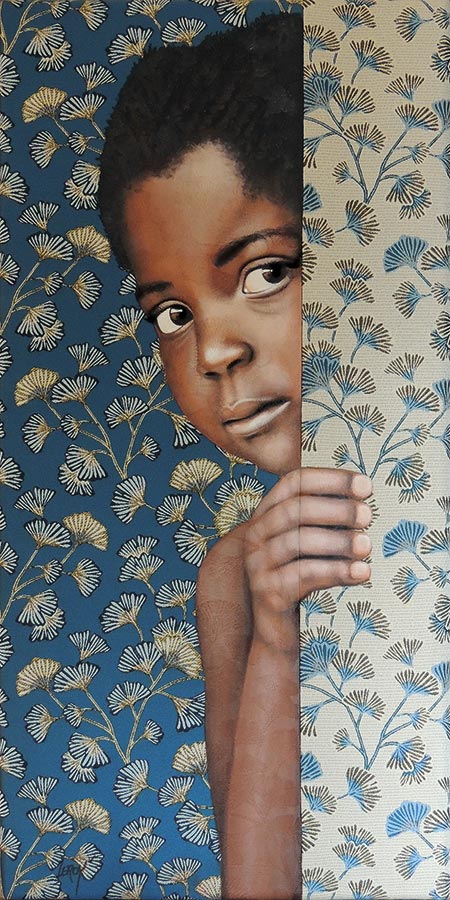
Les mots ‘textile’ et ‘texte’ ont la même racine latine texere qui signifie ’tisser’. Là où la trame et les mots se relient et s’entremêlent pour former un tissu de vérité. Des mots au tissu, il n’y a donc qu’un fil, dessinant le sourire d’un enfant ou le dessin d’un tatouage. Mes peintures s’accompagnent ici de vers, verbes ou versets, métaphores filées subtilement attachantes et inspirantes.
The words ‘textile’ and ‘text’ have the same Latin root texere which means ‘to weave’. The weft and the words bind and intertwine to form a web of truth. From the words to the fabric, there is therefore only a thread, drawing the smile of a child or the drawing of a tattoo. My paintings are here accompanied by verbs or verses, subtly endearing and inspiring metaphors.
III
Divine Comédie
Quand un artiste est prêt à tout pour avouer son amour à celle qu’il a toujours aimée. Elle se nomme Béatrice et elle disparait trop tôt, à seulement vingt-quatre ans. Pour la rejoindre, le poête florentin Dante Alighieri (1265-1321) traversera les neuf cercles de l’Enfer réunissant les damnés, puis le Purgatoire avec ses pénitents et ses repentis, et enfin les neufs ciels du Paradis peuplé d’anges et d’âmes pures comme Béatrice, jusqu’à atteindre l’Empyrée et la rose céleste. Il lui faudra quinze années, de 1306 jusqu’à sa mort en 1321, pour composer les 14 000 vers de l’incroyable et ‘dantesque’ recueil intitulé La Divine Comédie. Au-delà du parcours initiatique, c’est un véritable livre d’histoire peuplé de plus de 500 personnages, mythologiques et contemporains. On y croise ainsi Cerbère, Médusa, Adam et Eve, le roi David, Saladin, de nombreux évèques, papes et politiciens florentins, mais aussi nombre de prophètes, anges et démons. Théologique, éclairée, engagée, surréaliste, La Divine Comédie est tout à la fois, mais c’est surtout un voyage vertigineux dans le divin, de l’ombre vers la lumière, pour simplement, retrouver l’amour…
When an artist is ready to do anything to confess his love to the one he has always loved. Her name is Béatrice and she disappears too soon, at only twenty-four years old. To join her, the Florentine poet Dante Alighieri (1265-1321) will cross the nine circles of Hell bringing together the damned, then Purgatory with its penitents and its repentants, and finally the nine skies of Paradise populated by angels and pure souls like Beatrice, until reaching the Empyrean and the celestial rose. It will take him fifteen years, from 1306 until his death in 1321, to compose the 14,000 verses of the incredible collection entitled The Divine Comedy. Beyond the initiatory journey, it is a real history book populated by more than 500 characters, mythological and contemporary. We thus meet Cerberus, Medusa, Adam and Eve, King David, Saladin, many bishops, popes and Florentine politicians, but also many prophets, angels and demons. Theological, enlightened, committed, surreal, The Divine Comedy is all at once, but it is above all a dizzying journey into the divine, from shadow to light, simply to find love again…
Ô vous qui avez l’intelligence saine,
voyez la doctrine qui se cache
sous le voile de ces vers étranges
Dante Alighieri, La Divine Comédie, l’Enfer IX 61-63
